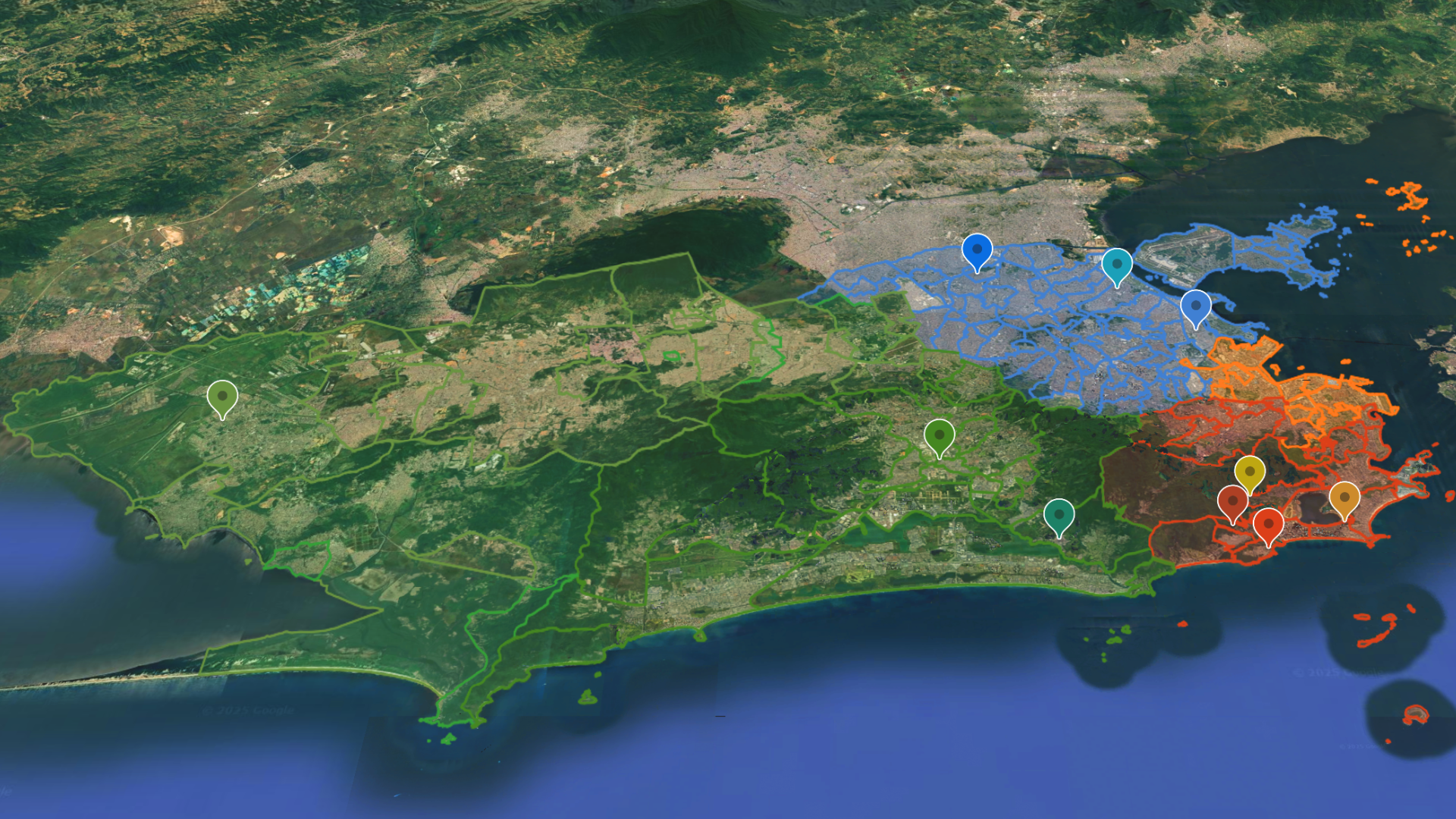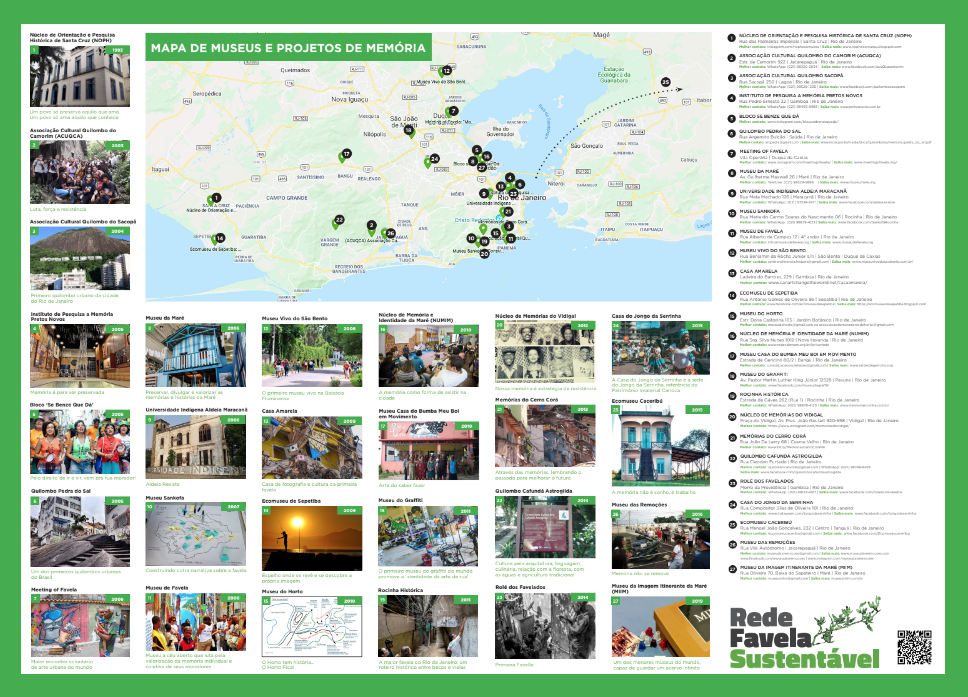Favela Climate Memory is a groundbreaking oral history project developed by eleven favela community museums within Rio de Janeiro's 1000-strong Sustainable Favela Network. The Favela Climate Memory Exhibition is a physical installation comprised of documentary, banners, interactive timeline, map and “Well of Memories,” resulting from oral histories gathered by local groups through 1,145 testimonials shared by 382 participants of discussion circles held across 10 favelas in 2023-2024. The full exhibition was launched in 2025.
Representing the three largest favelas in the city (Rocinha, Rio das Pedras and Maré), favelas marked by severe climate impacts (Acari, Vidigal and Pavão-Pavãozinho/Cantagalo), others that became destinations for climate-displaced populations (Antares and City of God), and communities with projects that are exemplary examples of coexistence with nature (Horto and Penha), four questions guided each community's discussions: Why was the area settled and what is the favela’s relationship with the climate and nature? What is climate change to you and in the eyes of your community? How does climate relate to housing rights? And: what knowledge has the community developed to respond to the challenges posed by nature and climate?
About the Climate Memory Circles
The exhibition brings together knowledge recorded during 10 climate memory discussion circles held by Rio de Janeiro favela museums in their communities between 2023 and 2024: Sankofa Museum (Rocinha favela), Historic Orientation and Research Nucleus of Santa Cruz (Antares favela), The Favela Museum (Pavão-Pavãozinho/Cantagalo favela), Vidigal Memories Nucleus (Vidigal favela), Alfazendo (City of God favela), Serra da Misericórdia Integration Center (Complexo da Penha favela), Horto Museum (Horto favela), Fala Akari (Acari favela), and Conexões Periféricas (Rio das Pedras favela).
The discussion circle format—‘focus group’ in social science terminology—was chosen not only for its high effectiveness in eliciting information as a research tool, but also for its role as a space for local empowerment through the collective construction of knowledge and mutual understanding.
Four guiding questions shaped the reflections during these gatherings:
How was the area settled and what is the favela’s relationship with the climate and nature?
What is climate change to you and in the eyes of your community?
How does climate relate to housing rights?
What knowledge has the community developed to respond to the challenges posed by nature and climate?
The climate memory circles held in these ten favelas were spaces for powerful testimonials. Always beginning with the residents’ relationship with nature, the circles brought forth a wide range of memories—marked by both tenderness and struggle. Even though many of the statements shared painful experiences, within the circle, that pain was reworked into a driving force for social transformation and empowerment.
Check out photo albums of each of the 10 circles:
2024: Alfazendo | Serra da Misericórdia Integration Center | Horto Museum | Fala Akari | Conexões Periféricas
Scroll through images from the process:
Watch the documentary “Favela Climate Memory” with English subtitles, featured in the exhibition:
About the Exhibition
Together, drawing from the life experiences and data gathered, the Sustainable Favela Network’s social museology collectives designed an exhibition to bring light and voice to the discoveries made during the circles, inviting the public to reflect on the plurality and deep interconnectedness of the climate memories of the favelas across the city.
There emerged the proposal for a richly detailed timeline with colorful panels representing key dates identified during the circles, banners highlighting powerful statements from residents in each circle, a documentary weaving together testimonials from various favelas around the key themes discussed, the deeply moving “well of memories” installation featuring nearly 300 photographs from the participating communities, and a hand-stitched interactive map where visitors can share their own memories.
The color-coded materials reflect the community that contributed each historical record: blue tones represent the city’s North Zone, earth tones the South Zone, and green tones the West Zone. In chronological order, the timeline presents key events in the histories of the favelas—and, in effect, of the entire city—from the 16th century to 2024.
At the center of the installation is the “Well of Memories,” where visitors can handle 265 captioned photos from the participating favelas.
Flip through photographs of the exhibition materials during the full exhibition launch that took place on May 3, 2025:
Check Out Our Video of the Exhibition Launch on May 3, 2025:
Exhibition Components
The Favela Climate Memory exhibition is comprised of the following materials, alongside the above video, currently being translated to English, which can be solicited per instructions below.
13 Banners (90x120cm each): Each banner contains the most emblematic quotes from each memory circle: Introduction to the Exhibition, 2023 Climate Memory Circles, 2024 Climate Memory Circles, Maré Museum Climate Memory Circle (Maré), NOPH Climate Memory Circle (Antares), Sankofa Museum Climate Memory Circle (Rocinha), Favela Museum Climate Memory Circle (Cantagalo), Vidigal Memories Nucleus Climate Memory Circle (Vidigal), Alfazendo Climate Memory Circle (City of God), Horto Museum Climate Memory Circle (Horto), Conexões Periféricas Climate Memory Circle (Rio das Pedras), Serra da Misericórdia Integration Center Climate Memory Circle (Complexo da Penha), and Fala Akari Climate Memory Circle (Acari).
60-Panel Timeline (50x100cm each): 60 panels covering dates identified by residents during the Climate Memory Circles, from the 16th century to 2024, color-coded based on the community that identified the event. The timeline can be held by bamboo clotheslines with sisal rope (3m high) on iron supports, forming pentagons with 5 plaques between each clothesline and the next.
Well of Memories (2.10mx1.10m): Handmade well made of reclaimed and new materials by artisan Evânia de Paula (Vidigal Memories Nucleus). Includes 265 numbered and labeled historical photographs of the 10 communities surveyed, to be handled by visitors.
Interactive Map (120x200cm): Produced by artisan Marli Damascena (Maré Museum). Canvas map with colored lines demarcating 5 planning areas of the City of Rio de Janeiro. Public is encouraged to affix messages and memories onto the map with available materials.
Sustainable Favela Network Museums Map (50x70cm)
Guidelines for Requesting Access to the Exhibition and Speakers
To invite the Favela Climate Memory Exhibition to your space or event, please send an official letter of invitation to press@catcomm.org. The opportunity will be discussed by the Climate Memory Working Group and we will reply within one month.
This letter should include:
The name of the event, who is organizing/inviting (department, individuals, institution), and the expected attendance.
Date(s) and time(s) of the event.
Location and format of the event.
Reason for the invitation, the purpose of the event, and how it connects with the climate memory exhibition.
Which activities/materials listed above are being requested and how you intend to incorporate them.
How many and which members of the Working Group are being invited to speak/present and anticipated presentation format.
The amount of travel assistance and honorarium that can be offered to participants.
Whether or not you will be able to cover a security deposit in case of damage to exhibition materials.
Whether a certificate or statement will be provided to participants after the event.













